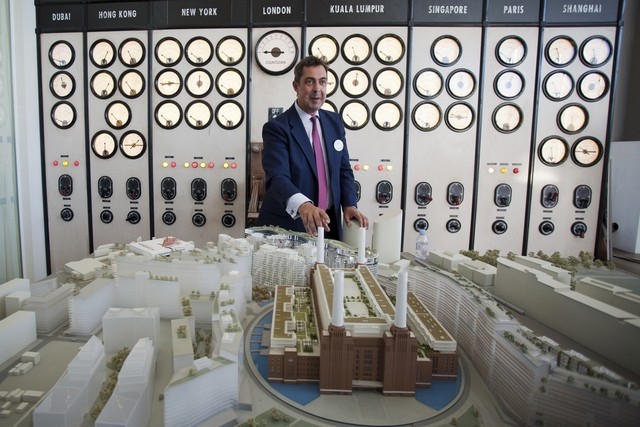
Battersea Power Station represents an opportunity for regional buyers to be a part of the last great development opportunity in the British capital.
Experience has taught Simon Murphy that when it comes to telling the Battersea story, it pays to take nothing for granted.
“I did a presentation a year or so ago and at the end I asked, ‘Are there any questions please?’” the Englishman says. “That’s when somebody said, ‘Don’t you think people will object to living so close to a power station?’”
The power station, decommissioned in 1983, is one of London’s most recognisable landmarks, and as Mr Murphy will explain to audiences in Abu Dhabi and Dubai this week, his answer to that question is a resounding No.
Mr Murphy is the chief financial officer of the Battersea Power Station Development Company, a Malaysian-backed consortium that is funding the building’s regeneration as part of an estimated Dh45 billion programme, making it the largest residential development in London.
He is in the UAE as part of a Middle East road trip to explain a scheme that has already attracted capital from the region.
Last year the National Bank of Abu Dhabi was one of 12 banks that took part in a Dh2.6bn Sharia-compliant loan, providing development capital for the second and third phases of the Battersea Power Station development.
The scheme promises to turn Battersea into the largest retail and leisure destination in central London, and will eventually include 4,000 new homes, 1.6 million square feet of office space, more than 40 restaurants and cafes, 150 shops, a 2,000-seat performance venue, 7 hectares of public open space and London’s newest Underground station.
“It’s not about the hard sell. It’s about raising awareness and developing relationships,” Mr Murphy says. “We’ve already raised every penny we need to and National Bank of Abu Dhabi was a part of that facility, so we don’t need to raise any more money for this project for the next five years – and potentially ever.
“The UAE events are partly for existing purchasers and also for other people who’d like to become a part of the Battersea story.”
His subject is certainly unique. With its four unmistakable chimneys, Battersea Power Station is as much a part of London’s architectural identity as Buckingham Palace, the Palace of Westminster, or Tower Bridge.
Its architect was Sir Giles Gilbert Scot, who is also responsible for the UK’s traditional red telephone boxes and Bankside Power Station, the building we now know as Tate Modern.
The first phase of Battersea was built just before the Second World War as the main source of electricity for West London.
The building is actually two power stations, the western Battersea ‘A’ and the eastern Battersea ‘B’, enclosed in the largest brick building in Europe. It is so large that its central boiler house is large enough to accommodate St Paul’s Cathedral, while each of its twin turbine halls is the equal of Tate Modern’s.
But unlike the Thames-side gallery, which opened in 2000 after 19 years of dereliction, Battersea has had to wait 32 years for its renaissance. It only escaped demolition after it was listed in 1980 as a building of outstanding architectural importance.
After several aborted attempts at redevelopment, the last of which collapsed in 2011, Battersea’s fortunes changed when the building and its associated 17 hectares of land were bought in 2012 for £400 million (Dh2.22bn).
The first residents are not due to move on to the site until this time next year, but the project has already started to change the reputation of this long-neglected section of London’s South Bank.
In November, almost four years before it is due to be completed, one of the power station’s fifth-floor apartments came back on to the market a few months after it had reportedly been bought by a Dubai buyer.
In less than a year the asking price had risen to almost Dh9 million, an increase of more than 30 per cent.
“It’s an entirely separate market from what’s going on in the real world,” the Kensington estate agent Chris Innes-Ker told the London-based Guardian newspaper at the time.
“It seems to be defying all logic. It’s creating a market of its own.”
Despite the excitement that surrounds Battersea among Middle East buyers and the agents who service them, the picture emerging from the London housing market is complex and the experience of investors, especially in markets whose currencies have depreciated against the British pound, is mixed.
As the latest Knight Frank Global Development Report has reported, not only has London become the world’s leading city for the global wealthy, but property prices in London have risen dramatically above New York, its nearest rival in the global luxury real estate market.
When the first phase of the Battersea Power Station development came up for sale in 2013, the sterling was relatively weak, demand for property among international investors was high, and the number of new London residential properties scheduled for construction had surged to its highest in 26 years.
But while prices along the South Bank, which now stretches from Tower Bridge to Battersea, have risen by more than 22 per cent since January 2013, brokers Douglas and Gordon reported a fall in the value of luxury homes in the Battersea and Battersea Park area of 10 per cent, in the 12 months to June this year.
In part this is the result of the strength of sterling compared with key investor currencies such as the Malaysian ringgit, the Singaporean dollar, the Chinese yuan and the Russian rouble, which lost 55 per cent of its value against the pound after Russian president Vladimir Putin’s annexation of Crimea last year.
“We are witnessing softening of interest among buyers from Malaysia and South-East Asian regions, probably due to the prevailing volatile currencies and uncertainty in economic outlook,” said Sime Darby Berhad, one of the three main investors behind the Battersea project, in June.
Battersea is at the western end of a River Thames stretch that runs between Vauxhall Bridge and Chelsea Bridge, and is regarded as the last great development opportunity in central London.
Formerly an overlooked and ignored tangle of warehouses, light industrial units, wholesale markets and railway viaducts, the area has traditionally been seen as the poorer cousin of neighbourhoods such as Chelsea and Westminster across the river.
Thanks to its designation in March 2012 as an “opportunity area” by the mayor of London and planning that set out an ambition to build 16,000 new homes, create up to 25,000 new jobs and a new park connecting Vauxhall with Battersea Power Station, all has changed.
The resulting development bonanza, a forest of cranes, scaffolding and construction hoardings, has been dubbed “Dubai-on-Thames” by a local newspaper and is attracting buyers and developers from the Middle East.
In June, Damac Properties of Dubai launched a 50-storey, 360-unit residential tower, Aykon Nine Elms, with interiors designed by Gianni Versace.
“A number of agents have said that the best investment opportunity in London property is Nine Elms, and within Nine Elms it’s Battersea Power Station, and we believe that,” Mr Murphy said on a recent tour of the Power Station.
“It’s finally OK now to say that you live south of the river. Taxi drivers will not say ‘No thanks, guv’ and drive away in the opposite direction.”
For Battersea Power Station Development Company chief executive Rob Tincknell, the appeal of the project lies in a complex “cocktail” of issues and not just in the luxurious size and finishes of the homes on offer.
They are, on average, 40 per cent larger than the London standard and have been particularly popular with buyers from the Middle East. Two-bedroom apartments planned for the roof of the power station measure 205 square metres.
“We’ve had a number of high net worth individuals from the Middle East,” Mr Tincknell says.
“One of our clients, who has just sold his penthouse in One Hyde Park, said he was fed up in Knightsbridge. There are too many people, he can’t go out anywhere without getting hassled, it’s too busy. He wants some peace and quiet and privacy.
“Knightsbridge and Chelsea and Mayfair will always be there and they will never change, but I think that change is happening.”
But he admits that it is the potential for significantly higher returns on investment in luxury properties south of the river that has excited buyers at Battersea.
“The Thames has been a natural barrier to values in London forever. Why? There’s no such barrier in Paris or Chicago, but here there is and that’s mainly because there’s been a lack of infrastructure south of the river,” Mr Tincknell says.
“Prices were about 50 per cent of the values in Central London over the river, but now we are about 80 per cent. That gap is narrowing substantially but it hasn’t happened here in Battersea yet.
“We are still incredibly affordable and people genuinely believe that the capital appreciation here is going to be much, much higher.”
 Comments ( 0 )
Comments ( 0 )
 Post a Comment
Post a Comment